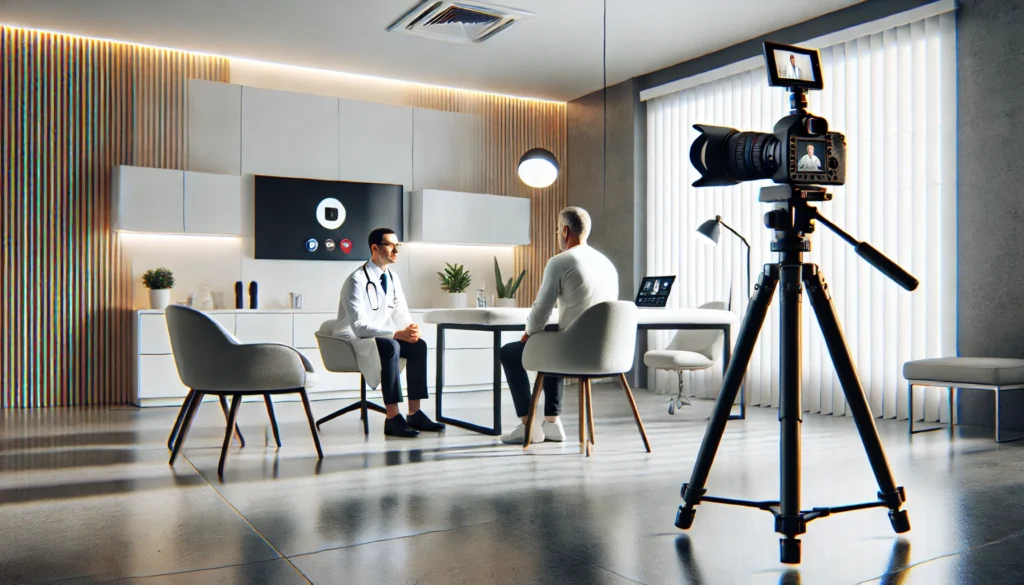Updated: 1 September, 2025
The Role of Video in Healthcare Education
In recent years, video technology has transformed the way healthcare professionals are trained. From medical schools to hospitals, educators are increasingly using video-based learning to enhance clinical education, improve communication skills, and refine decision-making processes.
By integrating video into training programs, institutions can provide students opportunities to formally review, analyse, and learn from others and their own interactions. It enables them to engage in deeper self-reflection by providing insight into how others perceive them. This approach is particularly valuable in fields like anesthesiology, where clear and effective communication is critical. As more universities adopt video-enhanced learning, its role in shaping the future of healthcare education continues to grow.
At the beginning of this year, I had the pleasure of interviewing two experts from the Department of Anesthesiology at Hamburg-Eppendorf University Medical Center, Parisa Moll-Khosrawi and Leonie Kröger. They recently integrated the Videolab tool into their curriculum to enhance medical training. In order to better understand how Videolab is being used in practice, we spoke with Parisa and Leonie. They share insights on why they adopted the tool, how it has been implemented, and the impact it has had on students, faculty and training.
The Need for Videolab: Challenges and Decision-Making
Effective healthcare education requires a combination of hands-on practice, structured feedback, and opportunities for reflection. At Hamburg-Eppendorf University Medical Center, video-based learning has long been a valuable tool in medical training. Traditional video recording and debriefing sessions have helped students analyze their clinical interactions and improve their communication skills.
Why Video-Based Learning?
Video-based learning offers several advantages in medical education:
- It allows students to observe and analyze their own interactions, which can improve self-awareness and communication skills.
- It provides opportunities for structured feedback, where instructors and peers can highlight specific moments for discussion.
- It enhances learning in complex training scenarios, such as emergency medicine or patient communication, where real-time observation may not capture every detail.
Recognizing these benefits, the department implemented Videolab to refine how students receive and process feedback. Unlike traditional video recording, this approach allows for detailed, time-stamped annotations, which help students identify specific areas for improvement.
Current Applications: Where Videolab is Used
Videolab is currently being used in two key areas within the Department of Anesthesiology:
- Chronic Pain Management – Helping students learn how to communicate effectively with patients experiencing severe pain while demonstrating empathy and active listening.
- Emergency Situations – Supporting students in developing team-based communication skills, which are essential for making quick, coordinated decisions in high-pressure scenarios.
By integrating video technology into medical training, these programs aim to provide a more comprehensive and reflective learning experience. The ability to review recorded sessions with structured feedback supports ongoing skill development and helps prepare students for real-world clinical interactions.
Key Purposes: Using Video for Student Feedback and Growth
At the Department of Anesthesiology at Hamburg-Eppendorf University Medical Center, video technology is primarily used to record simulated medical consultations. Since many of these training scenarios involve emergency medicine, video plays a crucial role in capturing real-time interactions for later review.
To facilitate this process, the team uses the Videolab Recorder App on iPads and tripods to set up cameras in training environments. These recordings allow both students and faculty to assess a range of clinical and communication skills. As mentioned above, the two main use cases are Emergency Scenarios and Chronic pain management sessions, students are encouraged to develop effective communication skills. Videolab also facilitates peer and mentor feedback, creating a collaborative learning environment.
The most valuable feature of Videolab for them has been the ability to provide fragmented feedback. This feature allows assessors to leave specific comments on precise moments during the interaction, targeting areas that need improvement. Unlike traditional video-based feedback in healthcare, which tends to be more general, Videolab’s timeline-driven comments enable highly personalised, detailed feedback, making it far more effective for skill development.
Additionally, educators can track student progress over time, ensure that learning objectives are met, and provide personalised guidance to help students refine their competencies.
Student Reactions and Feedback Effectiveness of Video in Healthcare
Integrating video-based feedback into medical training is a significant shift for many students, and initial reactions have been mixed. Some students initially find watching themselves on video uncomfortable, as it requires them to confront their own communication habits and clinical decision-making. However, as they engage more with the process, they recognize its value in improving their skills.
One key advantage is that students can revisit their recorded sessions at home, allowing them to reflect on their interactions at their own pace.
This additional time for review helps them process feedback more thoroughly, leading to deeper learning and self-awareness.
The feedback process typically unfolds in two stages:
- Group Review & Discussion – Students first watch their recordings together, guided by faculty and peers who provide structured feedback.
- Independent Reflection – They then have the opportunity to revisit their session later, reinforcing learning and allowing for more personal insights.
Expected Outcomes
The ultimate goal of using video-enhanced learning is to improve students’ ability to communicate effectively in clinical settings. While it is still early in the process, Parisa is optimistic that Videolab will support long-term development. By strengthening situational awareness in petite interactions, Videolab encouraging self reflection and enhanced communication skills training. As the program continues, faculty will assess how ongoing exposure to video feedback influences students’ confidence and competence in real-world healthcare environments.

Looking Ahead: The Future of Video in Healthcare Education
Both Parisa Moll-Khosrawi and Leonie Kröger see video technology playing an increasingly significant role in the future of healthcare training. In recent years, the industry has embraced innovation to enhance medical education, and integrating video-based learning is part of this transformation.
“Videolab will have a great impact on healthcare.” – Parisa Moll-Khosrawi
One of the most promising aspects of video-based training is its potential to optimise supervision. Instead of requiring real-time observation for every interaction, faculty can review recorded sessions asynchronously, providing feedback at a later time. This reduces the burden on supervisors but also enables multiple assessors to review and comment on a student’s performance, ensuring well-rounded evaluation.
Looking ahead, video technology could play a key role in redesigning postgraduate education. With the ability to record, analyse, and improve clinical interactions, video-based learning has the potential to reshape medical training, by making it more accessible, reflective, and data-driven. As healthcare institutions continue to explore new ways to enhance skill development and communication training, the role of video will likely become even more integral to medical education worldwide.
